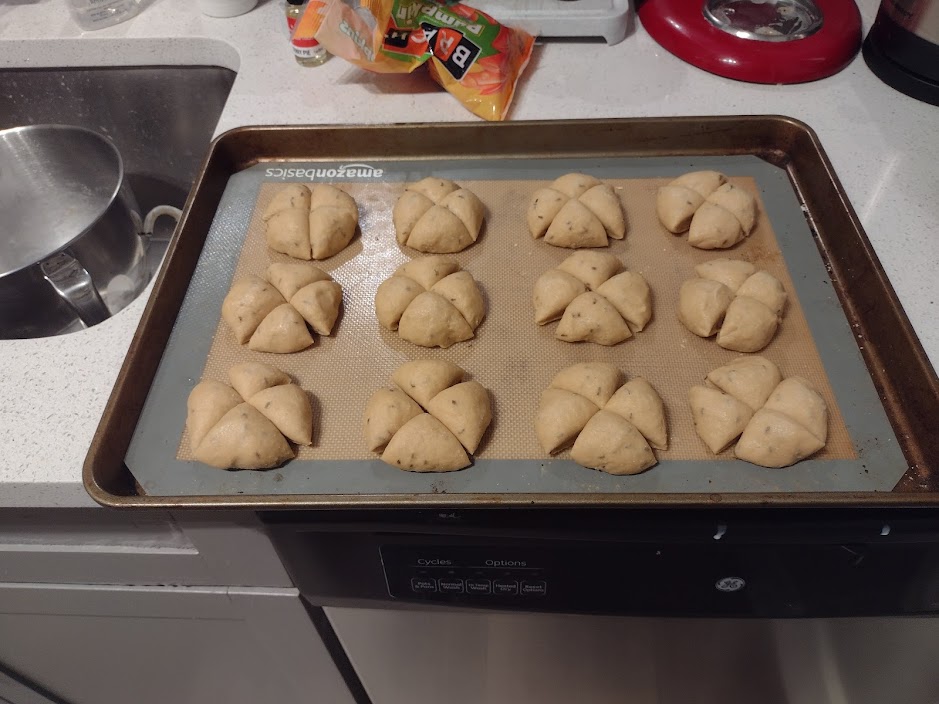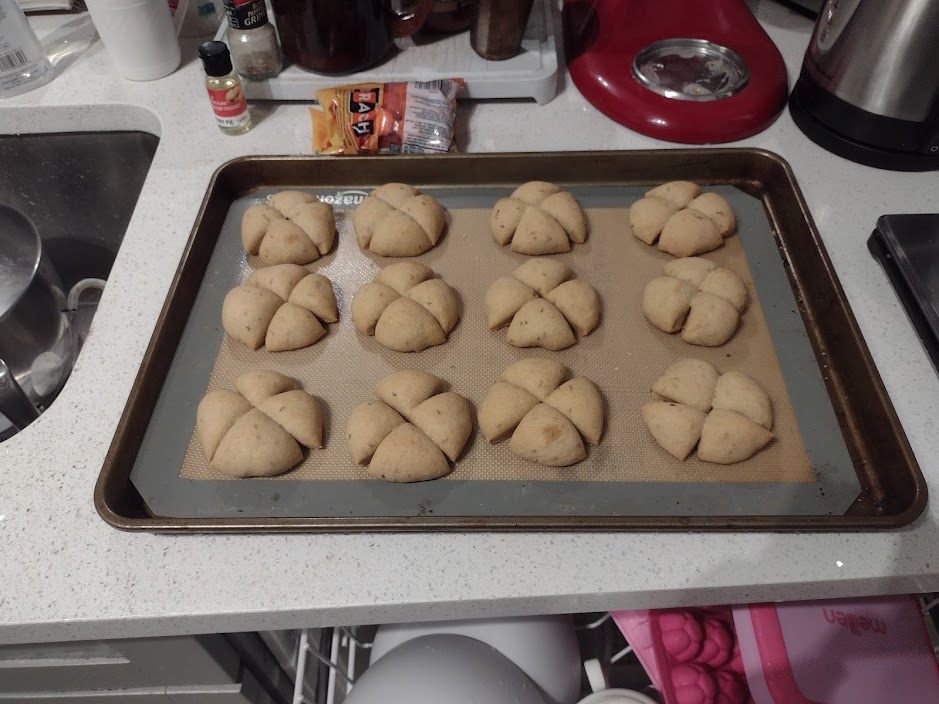Some time ago, Gastro Obscura wrote an article on the sifter, which is a front end to a cookbook database. If you are interested in tracking recipes over history, you can search on a term and find what cookbooks it was used in and when. The author did not know that “Wig” (or “Wygge” or “Wigg”) was a term for a kind of bun. Being that guy, I felt compelled to point that out, since I had made wiggs and time or two before. I’d even made them with ginger, because ginger is my thing. A correction was made and I spent a day or two just looking at the article in a bemused sort of way. I felt legit.
Now, when I make Wiggs, I treat them like a risen dough. Townsend made them and he treated the rise more like a resting period, than a full rise. Not being one to argue with a serious 18th century reenactor, I decided to try his method. I searched up recipes, and got the following.
Shackleford – The Modern Art of Cookery Improved (1767)
To make wigs.
Take 2 pounds and a half of flour, dry it before the fire, and when cold rub in a quarter of a pound of fresh butter, and 6 ounces of sugar; Mix half a pint of yeast that is not bitter, with warm milk, put this to the flour with some caraway seeds; Mix it to all together to a light dough, set it before the fire to rise, then make into what shape you please; Bake them in a slack oven.
You may have allspice beat fine, instead of carraways, if you please.
Cleland – A New and Easy Method of Cookery (1755)
To make wigs.
Take a quarter of a Peck of flour, rub into it 3/4 of a pound of butter, something more than half a pound of sugar, a little nutmeg and ginger grated, three eggs well beaten; Put to them half a mutchkin of thick barm, and a glass of Brandy, make a hole in your flower and pour it all in, with as much warm milk as will make it a in a light paste; Let it stand before the fire to rise half an hour, then make it into a dozen and a half of weeks. Bake them half an hour.
Glasse – Art of Cookery Made Plain and Easy (1774)
Wigs,
Take 3 pounds of well dried flour, one nutmeg, a little mace and salt, and almost half a pound of caraway comfits; mix these well together, and melt half a pound of butter in a pint of sweet thick cream, 6 spoonfuls of good sack, 4 yolks and three whites of eggs, and near a pint of good light yeast; work these well together, and cover it, and set it down to the fire to rise; then let them rest, and laid the remainder, the half pound of caraway comfits on top of the week, and put them up on papers well floured and ride, and let them have as quick an oven as for tarts.
The Carolina Housewife also had Wigg recipes, but we’re not going to discuss them. It’s from 1847 and they were more like pancakes or crumpets.
Townsend has facsimiles of all three books for sale if you want a paper copy. Having reviewed the recipes, I decide to go from Shackleford’s. I don’t use historical methods for baking, so I decided to take a look at how this would look as a modern recipe.
- 450g flour
- 45g butter (10%)
- 77g sugar (15%)
- 7g Salt
- 5g active dry yeast
- 300g Milk (~70%)
- 7g Caraway seeds
I add salt because I never keep salt in the house and most 18th century recipes assume salted butter. If they want unsalted, they will explicitly tell you to wash the butter. For spicing, you had a choice of caraway in either seeds or comfits – sugar coated seeds, or nutmeg and ginger mixed. I did 7g Caraway seeds on a whim, but I knew that would be a very strong taste. Last decision was what flour to use. Bread flour will give a roll type of structure, pastry flour will give a more cookie or cake texture and AP flour will be somewhere in the middle. I went with whole wheat pastry flour.
Method
Mix dry ingredients in mixing bowl. Melt butter and add to milk. Add to dry ingredients and mix until dough comes together. Since this uses whole pastry flour, do not expect it to feel like a bread dough.


After resting the dough, shape into 72g (2.5 oz.) balls and cut into quarters. The cut is what makes a Wigg a Wigg, since the name is derived from Middle Dutch (and Middle English) “wegge” or “wedge”.

After shaping, pre-heat the oven to 325.

If you are used to bread making, you can see there is not a lot of change during the rest periods, unlike after a rise. They taste find if you want to go with a full rise. After another rest, into the oven and give them about 30 minutes.

Texture and taste was much more cake-like than usual, and there was a strong element of caraway.